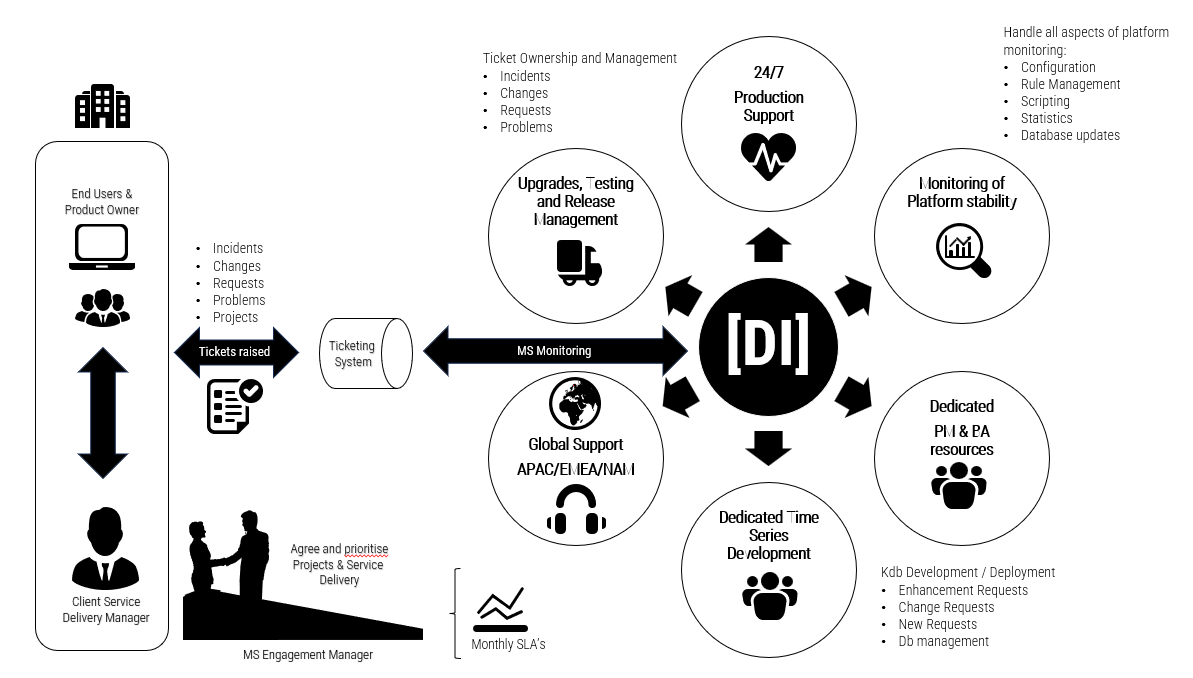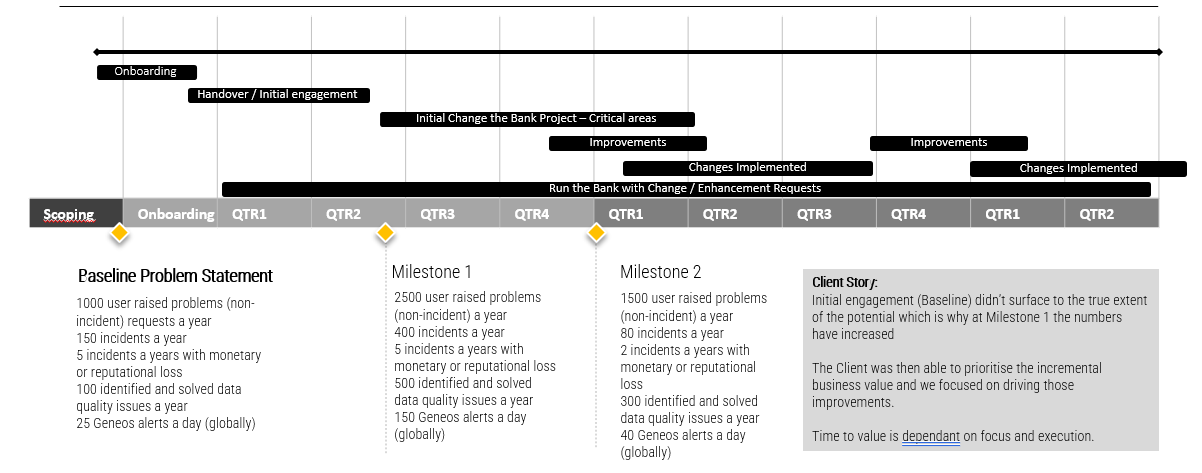Data Intellect
Data Intellect provide a full kdb+ Managed Service enabling their clients to focus on growing their business. Our industry partnerships, thought leadership, and ability to provide extensive services within the kdb+ technology space, enables our clients to leverage their technology within a long term engagement resulting in significant improvements in their business value.
There are many reasons why clients want a kdb+ Managed Service, here are a few we have experienced:
-
Conflicting business priorities at a client can result in some support functions giving precendence to something else. Clients would rather focus on their core business.
-
The standard of kdb+ support service can be inconsistent resulting in senior developers having to fulfill ancillary roles. This can lead to demotivated staff and lower productivity.
-
Total cost of support can often be difficult to see across multiple client teams, therefore business value is hard to determine.
-
Finding and scaling skilled kdb+ resources to fit with business growth and shrinkage can be difficult.
Managed Services with Data Intellect

There are numerous reasons to partner with Data Intellect in a Managed Service.
Get the Expertise and Domain knowledge you need.
-
-
Data Intellect has significant experience in providing support around kdb+ technologies. We have deep resource pools capable of dealing with the most complex problems. Not only that, we have supporting divisions in Software Engineering, Data Science and Project Management which enable us to offer a full service.
-
Focus on Core Activities – driving out business value.
-
-
Trusting MS with Data Intellect frees up your employees to focus on the jobs they were hired to do.
-
Keep Costs Low.
-
- Eliminate hiring and training costs. We provide nearshore, onsite, hybrid or remote options globally. This gives our clients opportunities to widen their resource base whilst controlling costs.
Scale up or down when needed.
-
-
Flex the service based on need and required levels of user support. As one of the largest kdb+ resource providers we are well placed to meet any changes.
-
Reduced Down time and Improved Uptime.
-
-
Rather than sit and wait for something to go wrong, Data Intellect take a proactive approach to problem management. Monitoring and Analysis through our Platform Oversight service ensures expensive down time is avoided.
-
24/7 Support.
-
-
Data Intellect have a global footprint enabling us to provide a ‘follow the sun’ model when it comes to Support Services. Our Tier 1 Financial Services clients benefit from this level of coverage with continuous levels of Service being provided across all regions.
-
Consistent Service Levels.
-
-
Managed Service Provisions often come with long term client engagements which allow trust and partnerships to develop. Service Level Agreements underpin these engagements giving the client control of their production environment and a consistent level of service over the long term.
-
Compliance and Regulatory Adherence.
-
-
Data that must be maintained in a secure way that is compliant with relevant industry regulations is an absolute priority. Data Intellect work closely with client legal teams to ensure all regulations are included within the service, adhering to Compliance needs at all times.
-
Thought Leadership.
-
-
Data Intellect understand that clients not only want to focus on costs, they want to get faster and more innovative. MS partnerships offer access to expertise and knowledge that help accelerate enterprise transformation and performance around capabilities that our clients view as critical—and sometimes even differentiating. Data Intellect’s expertise makes them well place to provide thought leadership through their MS partnerships enhancing client capabilities as they strive for competitive advantage.
-
Data Intellect – trusted partnership with KX.
-
-
By integrating KX’s high-speed time series database with Data Intellect’s specialized data science capabilities, clients gain a more comprehensive, efficient, and insightful analytics platform, enabling them to make better-informed decisions faster. We are a trusted partner of KX and have been working with the technology since inception. We understand all the needs associated with the kdb+ landscape and have access to KX’s senior technical resources.
-
How we do it – the 3 phases of Data Intellect Managed Service Transition
The ability to successfully transition new accounts into a steady state operation is vital. The term, transitioning, applies to a set of activities that our Data Intellect MS Team employ to enter into a new IT environment and take over its operations. This type of engagement usually spans 90 days from kickoff to go live. In that period, several tasks must take place, from obtaining environment access and identifying gaps, to documenting the environment for the incoming support team. Data Intellect MS transitions follow a 3-phase structure; Discovery, Assessment, and Operational Integration. Each phase has its own unique tasks and objectives to meet for the transition process.
Discovery Phase
The discovery phase is a set of tasks designed to provide a base of operations for the team.
Access to the Environment.
-
-
Obtaining access to the environment is the foundation of a transition. No other transition work can be performed without access. The process should be started as soon as possible.
-
Discovery of the Environment.
-
-
Once the team has access, they can begin surveying the environment.
-
Creating an Activity Matrix.
-
-
With the knowledge gained from access and discovery, building of an activity matrix can begin. An activity matrix is a chart of tasks performed to manage an environment. The matrix is a roadmap for BAU operations (what gets done by whom and when).
-
Attending Operational Meetings.
-
-
Operational meetings are sources of formal and informal information in the account’s environment. These meetings will reveal the leaders, operational process flow, and pain points existing in an environment.
-
Developing a Gap Analysis.
-
-
All transition projects will have gaps of some kind. Gaps are differences between the current operations of an environment and established best practices, as well as informal processes of the customer versus formal activities documented in the account contract. Gaps can also involve pain points that the customer wants to address during the transition process. The Gap Analysis is the final step in the discovery process. It identifies what needs to be learned, documented, and managed in the environment. It’s important that the analysis be thorough so that the account contract team can set expectations of the level of service at go live and also have a plan for closing the gaps through knowledge, training, and maintenance.
-
Assessment Phase
The assessment phase is where the Data Intellect MS team takes the knowledge and materials obtained through the discovery phase and organizes them into documentation and processes that will be used by the operations staff.
Standard Operating Procedures (SOPs).
-
- A goal of every MS Team is to have an SOP associated with every action or change performed in an environment. SOPs provide a repeatable template for performing an operation. Some accounts will require an SOP for any change occurring in the environment. If there’s existing SOP documentation, it’s important that it’s validated. Our team will need to decide if existing SOP documentation is useful or if new SOPs need to be developed. If tasks and processes have no SOPs, it’s important that they are declared as gaps and a plan to develop the documentation be stated in the Gap Analysis
Training Materials and Runbook.
-
- The operational team will need training to perform daily tasks. The team will also need to understand the account’s Service Level Agreements (SLAs) and Key Performance Indicators (KPIs). Protocols, procedures, and communications relating to emergencies and major outages will also need to be covered by the team. At the end of this process a Runbook is created that contains all of the above information. The Runbook is what will be used to train new team members and can also be used during account service auditing processes.
Integration to Client Stakeholder teams.
-
- Our Data Intellect MS teams often integrate within stakeholder Client teams and almost become an extension of those teams. It’s essential DI and the client understand how this integration operates and clarify the mechanism for ensuring clear, transparent lines of communication.
Operational Integration Phase
Operational Integration is the final transition phase. It is where our team is prepared to take over the account’s environment. The individuals present in this phase will make up the production or steady state team post go live.
Shadowing and Reverse Shadowing Sessions.
-
- Shadowing is the process of observing the work of an experienced staff member. It is a demonstration of how a job is performed. At some point prior to go live, the shadowing will be reversed. During reverse shadowing, the steady state team members perform the processes to demonstrate their ability to take over an assigned job.
Delivery Assurance (DA).
-
- The output of the DA process is a report that specifies that members of the steady state team have proven the ability to perform the contracted operational tasks.
Completing Account Deliverables.
-
- This task involves completing any infrastructure (equipment or software) installs that are part of the contract and delivering any required operational Runbooks or
documentation.
- This task involves completing any infrastructure (equipment or software) installs that are part of the contract and delivering any required operational Runbooks or
Go Live is the date and time when an account’s environment is officially handed over to our MS team. The end result is a Business as Usual Managed Service Landscape outlined below:

Data Intellect – Case Study
Starting Point.
-
-
Team of 8 developers globally working on a kdb+ transaction data system.
-
General support from the Equities Level 2 support team. Non-kdb+ specialists looking after > 10 applications.
-
L3 support was performed by developers and was taking up a significant amount of development time.
-
Good monitoring, using internally collected data, but restrictive, limited and rarely updated.
-
Incidents were infrequent, but often quite major when they were discovered.
-
Outages caused by disk space and memory issues were common.
-
SLA to downstream applications was breached often
-
After 6mths.
-
-
Tripled the number of monitoring checks
-
Reworked a lot of existing checks to ensure they were accurate and to reduce noise.
-
Implemented changes to solution architecture in order to improve debugging capabilities.
-
Number of problems and incidents increased by around 2.5x as we began to pro-actively uncover problems with the data and the code base.
-
Major outages stayed at the same level.
-
Reduced the developer hours spent on L3 coverage by around half. Over 50% of requests and minor issues were solved without L3 being required.
-
SLA breaches began to decrease.
-
Userbase doubled in size.
-
After 1yr.
-
-
Increased the capabilities of our monitoring system further to allow advanced commands, alerts, dynamic monitoring.
-
Number of problems began to decrease to around the original level (per user) and incidents decreased below original user. 95%+ of problems were solved within same working day and incidents generally had lower impact.
-
Reduced developer hours spent on L3 coverage to 0, unless all-hand incidents were called. DI support team found bugs, and raised suggested fixes in Jira tickets. In high impact situations these were often solved in memory/on disk with incident tickets, with developers only approving/four-eyes checking the changes.
-
Major outages and SLA breaches decreased.
-
Cost of Managed Service was reduced due to operational efficiency gains, despite new applications being added to the Managed Service remit
-
Amount of data captured tripled and userbase continued to increase.
-

Data Intellect – a trusted advisor in Capital Markets technology
We are a data and technology consultancy firm and our key area of expertise is financial and capital markets technology solutions. This proprietary offering is complemented by a wealth of experience in data engineering, electronic trading systems, data capture applications, regulatory and compliance systems and middle and back office enterprise web solutions.
Data Intellect’s Managed Service offering takes the very best out of these vast resource pools and applies it to complex problems. Our company values of ‘Can do Attitude’ and ‘Problem Solvers’ lend themselves perfectly to working in partnership with Clients, for whom we are a trusted advisor, defining the questions they need answering, adding insight and know-how and then implementing data solutions that advance the strongest outcomes.
Share this:

















